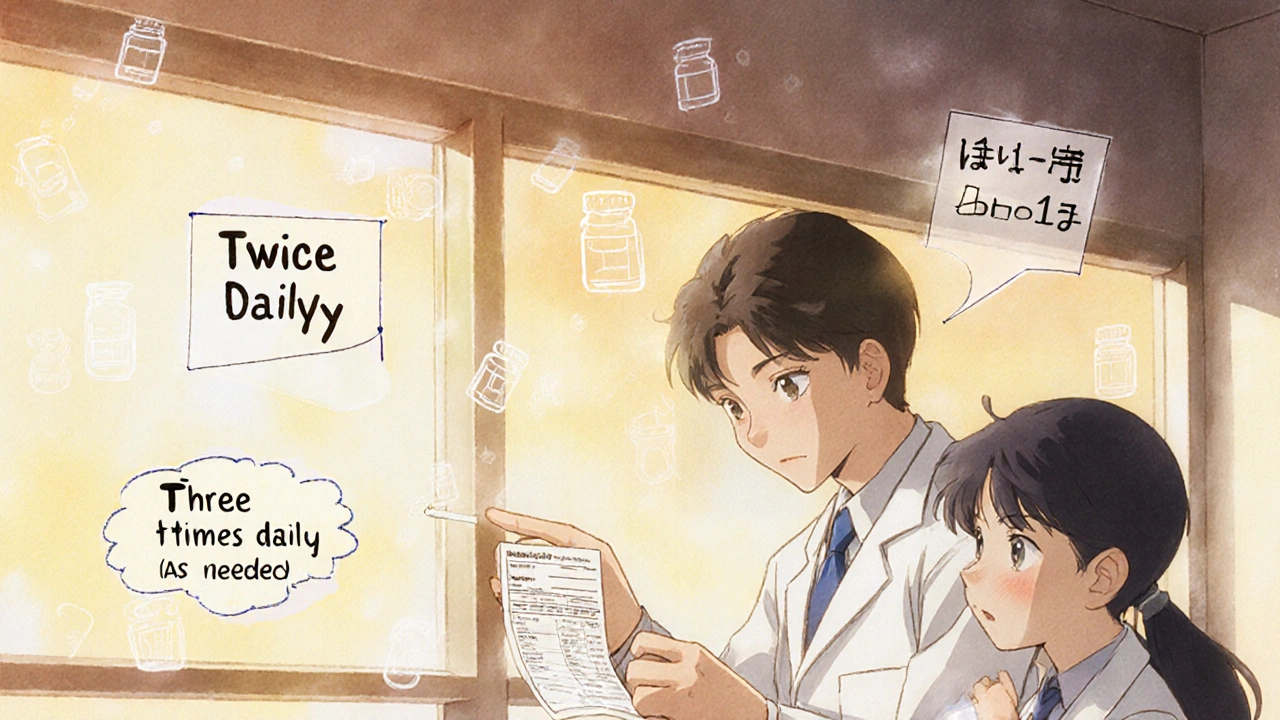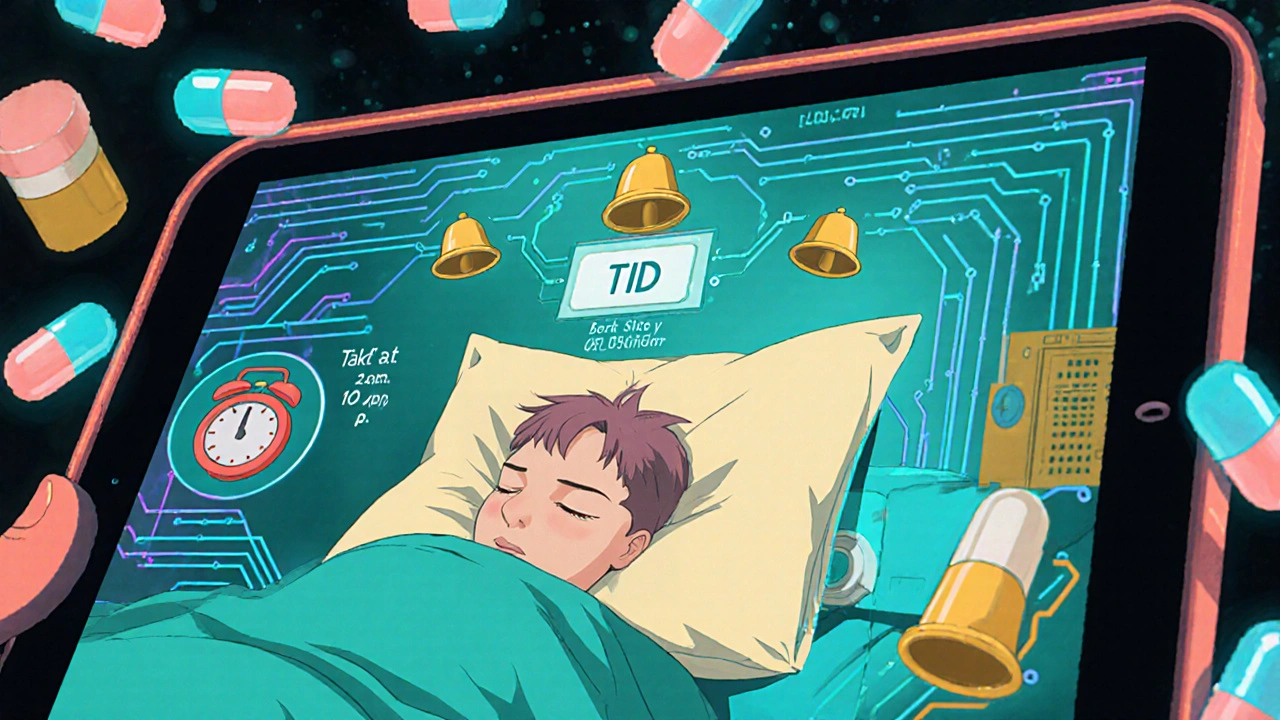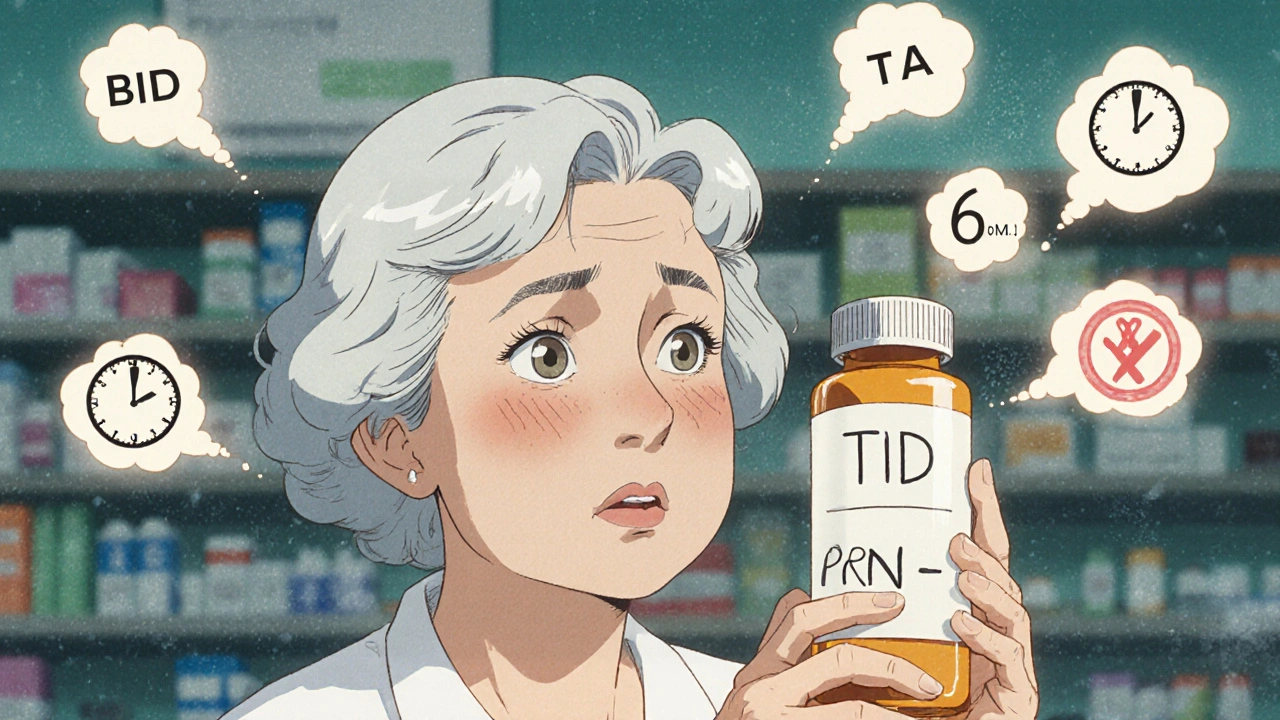Ever stared at your prescription label and felt like you’re decoding a secret code? You see BID, TID, and PRN-and suddenly, you’re not sure if you’re supposed to take your medicine twice a day, three times a day, or only when you feel like it. You’re not alone. Nearly 7 out of 10 patients in the U.S. admit they don’t fully understand what these abbreviations mean. And the stakes? High. Taking a medication wrong can mean it doesn’t work-or worse, it causes harm.
What BID, TID, and PRN Really Mean
These aren’t random letters. They’re Latin abbreviations that pharmacists and doctors have used for over a century to save space on handwritten prescriptions. Today, even with digital systems, they’re still everywhere. Here’s what they actually mean:- BID stands for bis in die-Latin for “twice a day.” That means two doses, roughly 12 hours apart. For example, 8 a.m. and 8 p.m.
- TID means ter in die-“three times a day.” Doses should be spaced about 8 hours apart: 6 a.m., 2 p.m., and 10 p.m. Skipping the middle dose or taking them only with meals throws off your drug levels.
- PRN is pro re nata-“as needed.” This doesn’t mean “whenever you feel like it.” It means take it only when you have the specific symptom listed, like pain, fever, or anxiety, and never more than the maximum daily limit. For example: “Ibuprofen 400 mg PRN for pain, max 3 doses in 24 hours.”
Other common abbreviations you might see:
- QD or qd = once daily
- QID = four times a day (every 6 hours)
- AC = before meals
- PC = after meals
- HS = at bedtime
- PO = by mouth
But here’s the catch: not everyone writes them the same way. Some doctors type “BID” without periods. Others use lowercase “bid.” Some even write “T.I.D.” with dots. The inconsistency makes it harder to read-and increases the risk of mistakes.
Why Timing Matters More Than You Think
Taking your medicine at the right time isn’t just about following rules-it’s about keeping the right amount of the drug in your body. Antibiotics are a perfect example. A 2021 Johns Hopkins study found that when patients took TID antibiotics with uneven spacing-say, 6 a.m. and 8 p.m., but skipped the 2 p.m. dose-the treatment was 27% less effective. The bacteria had time to bounce back.Same goes for blood pressure meds. If you take your daily dose at 8 p.m. one day and 6 a.m. the next, your blood pressure might spike overnight. The goal isn’t perfect clock timing-it’s consistency. The American College of Clinical Pharmacy says a ±15% variation is okay. So for a TID dose, 6-9 hours between doses is fine. But if you’re going 14 hours between doses? That’s too much.
PRN medications are even trickier. A 2021 FDA report found that 31% of all dosing errors involved PRN meds because people either took them too often or didn’t take them when they should have. One patient took her PRN painkiller every 2 hours because she thought “as needed” meant “as often as you want.” She ended up with liver damage. Another didn’t take hers at all because she didn’t feel pain-until she had a migraine so bad she couldn’t move.
Why These Abbreviations Are Still Around
You’d think by 2025, we’d have ditched Latin terms for plain English. But we haven’t. Why?First, tradition. Many doctors were trained using these abbreviations. A 2024 study in the New England Journal of Medicine found that 38% of active U.S. physicians are over 50-and nearly half still use “BID” and “TID” out of habit.
Second, electronic systems still auto-fill them. Even if your doctor types “twice daily,” the pharmacy’s software might convert it to “BID” because that’s what’s in the system’s default template.
Third, there’s resistance. In a 2022 survey, 34% of doctors believed Latin abbreviations were “more precise.” They’re wrong. Plain English is clearer. And it’s safer.
The good news? Change is coming. The United States Pharmacopeia (USP) has set a hard deadline: all Latin abbreviations must be gone from prescriptions by December 31, 2025. Kaiser Permanente switched to plain English in 2022-and saw a 29% drop in patient calls asking for clarification.

What You Can Do Right Now
You don’t have to wait for the system to fix itself. Here’s how to take control:- Ask your pharmacist to explain it. Seriously. They’re trained to do this. A 2022 survey found 89% of patients felt more confident after a pharmacist walked them through their label. Don’t feel shy. They’ve heard it all before.
- Use the “teach-back” method. After they explain, say: “So, just to make sure I got it-you’re saying I take this pill twice a day, morning and night, even if I feel fine?” If you can say it back correctly, you understand it.
- Write it down in plain English. On the prescription bottle, stick a small note: “Take 1 pill at 8 a.m. and 8 p.m.” Or use a pill organizer with time slots labeled “Morning,” “Afternoon,” “Evening,” “Bedtime.”
- Use a medication app. Apps like Medisafe (used by over 18 million people) let you scan your prescription and it automatically converts “TID” to “Take at 6 a.m., 2 p.m., 10 p.m.” Then it sends you phone alerts.
- Do a “brown bag review.” Once a month, bring all your pills-even the empty bottles-to your doctor or pharmacist. They’ll spot duplicates, interactions, or confusion you didn’t even know you had.
What to Watch Out For
Not all labels are created equal. Chain pharmacies like CVS and Walmart now include plain-English instructions on 74-78% of prescriptions. But independent pharmacies? Only 41% do. If yours doesn’t, ask for a printed sheet that explains it in simple terms.Also, be careful with international variations. If you travel, a prescription that says “BD” (used in the UK for twice daily) might confuse you. In the U.S., “BD” isn’t standard. It could be mistaken for “bedtime.” Always double-check with a local pharmacist if you’re abroad.
And never assume. One Reddit user shared how their grandmother took her TID antibiotic only twice a day because she thought “TID” meant “three days.” She finished the bottle in three days instead of ten-and the infection came back worse.

What’s Changing by 2026
By 2026, federal rules will require all prescription labels to use plain English. No more “b.i.d.” No more “t.i.d.” Just “take twice daily.”Some pharmacies are already ahead of the curve. The FDA is testing new digital tools that let you enter your wake-up and bedtime times, and the app calculates exact dosing times for you. Imagine typing in “I wake up at 7 a.m. and go to bed at 11 p.m.” and the system tells you: “Take your pill at 7 a.m., 3 p.m., and 11 p.m.” That’s coming soon.
By 2030, experts predict less than 5% of prescriptions will use Latin abbreviations. The old ways are fading. But until then, you’re the best defense against mistakes.
When in Doubt, Ask
The single most effective thing you can do? Ask. Don’t guess. Don’t assume. Don’t Google it and hope you got it right.A viral TikTok video by pharmacist Anna (@PharmacistAnna) got over 2.4 million views because she said: “If you can’t read it or don’t understand it, ask. We expect these questions.”
Pharmacists aren’t there to judge. They’re there to keep you safe. And if they don’t explain it clearly the first time, ask again. Or ask someone else. Your health is worth it.


Gordon Mcdonough
November 17, 2025 AT 07:44So let me get this straight-we’re still using Latin on prescriptions in 2025?!!? That’s like using a rotary phone to call 911. My grandma thought TID meant three days and finished her antibiotics in three days-then got sepsis. This is not tradition, it’s negligence. Someone needs to get fired.
Jessica Healey
November 18, 2025 AT 12:38OMG YES. I took my blood pressure med at 8pm one night and 6am the next and my head felt like it was gonna explode. I didn’t even know timing mattered that much. Now I set alarms. And yes, I write ‘take at 8am & 8pm’ on the bottle. My pharmacist laughed but gave me a sticker that says ‘YOU’RE WELCOME’.
Levi Hobbs
November 18, 2025 AT 21:57I work in a pharmacy, and I can confirm-this is a huge problem. Patients get confused, and it’s not their fault. The system is outdated. We’ve started printing plain-language inserts with every script, and our error rate dropped by 40%. Also, ‘BID’ vs. ‘bid’? It shouldn’t matter-but it does. One patient took his med every 4 hours because he thought ‘b.i.d.’ meant ‘every 4 hours.’ We need consistency.
henry mariono
November 20, 2025 AT 01:17Thanks for this. I never knew about the ±15% window for dosing. I’ve been stressing over being exactly 8 hours apart. This helps. I’ll start using the Medisafe app. Also, I’m going to bring my brown bag in next month.
Sridhar Suvarna
November 21, 2025 AT 12:12In India we use BD and TDS, but many patients don’t understand either. I’ve seen people take insulin BD thinking it means twice a week. Language must be clear. This article is a lifeline. Thank you for explaining the science behind timing. I will share this with my family and community.
Joseph Peel
November 22, 2025 AT 01:08The shift to plain English is long overdue. Latin abbreviations were never meant to be patient-facing. They were shorthand for professionals. When we started using ‘twice daily’ on our clinic’s e-prescriptions, our patient compliance rose 22%. Clarity isn’t dumbing down-it’s dignity.
Kelsey Robertson
November 22, 2025 AT 23:49Of course it’s ‘BID’-it’s Latin! Why should we dumb down medicine for people who can’t read? If you can’t understand ‘TID,’ maybe you shouldn’t be taking pills at all. Also, why is everyone so obsessed with apps? My grandmother took her meds with a pocket watch and lived to 94. You’re all just addicted to notifications.
Gordon Mcdonough
November 23, 2025 AT 03:33Wow. Just… wow. You’re the reason we have a public health crisis. Your grandmother had a pocket watch? That’s cute. My cousin died from a PRN overdose because she didn’t know ‘as needed’ meant ‘not every hour.’ Maybe you should stop giving medical advice and start reading something that wasn’t written in 1923.